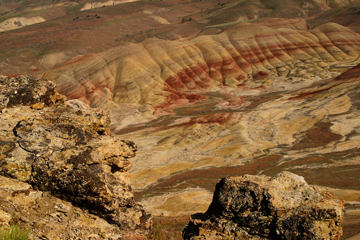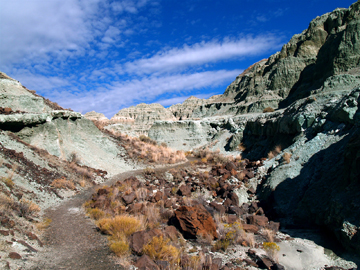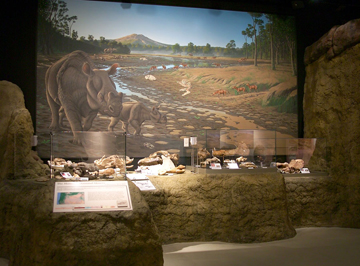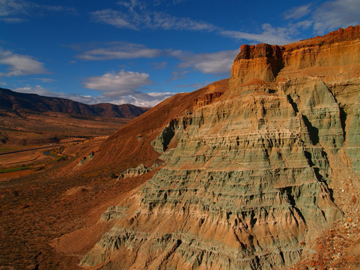|
Travels in Geology March 2008 posted March 19, 2008
Finding fossils in John Day
Mary Caperton Morton
 National Park Service |
| The painted hills of John Day Fossil Beds National Memorial are filled with fossils from millions of years ago. |
On the surface, the painted hills of the John Day Fossil Beds National Memorial in eastern Oregon are spectacular, but it is what lies beneath the rolling red landscape that makes this desert region famous. Buried within the underlying layers of volcanic tuff are the world’s richest fossil beds from the Cenozoic Era, also known as the “Age of Mammals.” Fossil beds that span more than a few million years are rare. Yet, these layers extend across more than 40 million years of history, making the beds at John Day one of the most complete records of ancient life anywhere on Earth — and definitely worth a visit.
The John Day fossil beds lie in the rain shadow east of Oregon’s two towering mountain ranges, the Coast Range and the Cascades. The mountains to the west are what make this region an arid desert today, but the layers of rock that formed the fossil beds were actually deposited from ancient volcanic eruptions to the east long ago. Thirty million years ago, prevailing winds blew tons of ash onto John Day’s once lush grasslands, marshlands and forests, burying foraging rhinos, horses and giant ground sloths. Now, every summer, vicious thunderstorms sweep the region, eroding the fragile aquamarine-colored tuff and washing fossils from more than 100 different species of mammals from the steep hillsides.
 Mary Caperton Morton |
| Hiking the Island in Time Trail and the Blue Basin Overlook Trail are great ways to experience the John Day sites and scenery. |
The fossil beds are protected within the John Day National Monument, which is divided into three separate parks: the Painted Hills, Sheep Rock and the Clarno units. To visit the beds, start at the Sheep Rock unit, which lies just northwest of Mitchell, Ore., which is about two hours east of Bend. Here you can visit the park’s main facilities and fossil museum at the Thomas Condon Paleontology Center. The museum features many beautiful fossils, interactive displays, audiovisual presentations and even a window into the park’s paleontology lab where scientists prepare and study fossil specimens. Knowledgeable park rangers and paleontologists give regular talks about the displays and geology of the region and are always willing to recommend the best hikes to see the fossil beds firsthand.
Hiking the Blue Basin Overlook Trail, combined with the shorter, adjoining Island in Time Trail, is the best way to experience both the intrepid geology and spectacular scenery of John Day. Both trails begin five kilometers west of the museum on Highway 19. The four-kilometer Blue Basin Trail is a loop, more easily hiked clockwise, that ascends to the top of the basin and overlooks the blue-tinged fossil-rich outcrop where most of John Day’s fossils are found. The hike to the top is mildly strenuous, but rewarding. From here the views of the painted hills and surrounding landscape are breathtaking. The vantage point also provides a unique view overlooking the 40 million years of history preserved within the Blue Basin below. The trail then descends into the basin itself, where it meets up with the Island in Time Trail and explores the fossil outcrops up close. Several specimens, including a turtle shell and a saber-tooth-tiger-like oreodont skull, are displayed under plastic capsules where they were found protruding from the hillside. You might also run into a park paleontologist combing the walls of the Blue Basin for newly exposed fossils.
 National Park Service |
| Be sure to stop by the Thomas Condon Paleontology Center to get an up-close view of some of the many mammal fossils that have washed out of the hillsides in this park. |
If you are one of the lucky visitors who finds a fossil, don’t touch it! Make note of its location and report the find to a park ranger as soon as possible. Recording the exact location of the fossil within the layers of strata is just as important as recovering the fossil itself and best left to a professional. While the plethora of large mammal fossils is perhaps the most exciting relic found at John Day, the preservation of the changes in forests and grasslands in an unbroken sequence also makes these fossil beds remarkable. This is one of the few places in the world where the evolution of an ancient habitat, along with the forces that brought sweeping ecological change, can be studied. Four distinct ecological eras divide the strata at John Day, each with its own unique set of fossils, which is why recording the exact location of a fossil find is imperative.
The oldest rocks at John Day, deposited between 50 million and 35 million years ago, make up the Clarno Formation, best preserved at the Clarno Unit. A bounty of fossilized nuts, seeds, leaves and other woody structures, including remains from a banana tree, indicates that this region of Oregon was covered by an evergreen tropical forest during this time period. Fossils of brontotheres and amynodonts, giant browsers that resemble horses and rhinos, can be found here, none of which left descendants to modern times. The Clarno strata give way to the John Day Unit strata around 37 million years ago, marked by the invasion of deciduous forests into the region. Recognizable mammals make their appearance here, including ancient relatives of wolves, pigs, large cats, horses, camels, rhinos and rodents. Thick deposits of basaltic lava mark the interval between the John Day and Mascall formations, starting around 20 million years ago. It took about 5 million years for the area to cool and regrow into warm, wet savannah grasslands with pockets of hardwood forests. Animals found here include massive grazers like gomphotheres (elephant-like creatures), rhinos and extinct bear-dogs. The youngest strata making up the Rattlesnake Formation begin around 8 million years ago. Here the climate became much drier with the rise of the great modern mountain ranges to the west, killing off the forests and allowing the grasslands to expand. Grazing mammals like horses, pronghorns, sloths, rhinos, camels and peccaries dominate the fossil layers during this time period.
 Mary Caperton Morton |
| Dozens of hiking trails snake through the park and due to summer and winter temperatures that can reach extremes, spring and fall are the best times to visit. |
Dozens of hiking trails snake through the park and river rafting and fishing for bass and trout on Service Creek are also popular ways to enjoy this beautiful region of eastern Oregon. Whether you are a fossil buff, a maven of deep geologic history, a river rat or a lover of spectacular desert scenery, the John Day fossil beds have something to offer everybody.
To get to John Day, which is in the middle of the vast eastern Oregon desert, drive northeast from Bend on scenic Highway 26. The route passes many notable natural attractions, including Smith Rock State Park, a rock climber’s paradise. Rustic park service campgrounds abound south of the highway, and Clyde Holliday Recreation Area, near the town of John Day, has full RV hookups, yurts and cabin rentals. Desert temperatures can be stifling in the summer and frigid in the winter so try to visit for a few days in the spring or fall.
Links:
John Day Fossil Beds National Memorial
Smith Rock State Park
Clyde Holliday Recreation Area
Back to top

 Subscribe
Subscribe


